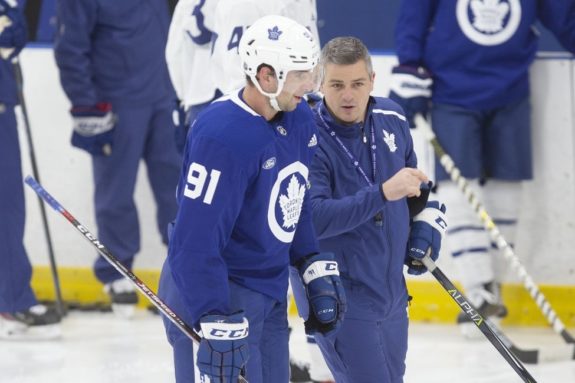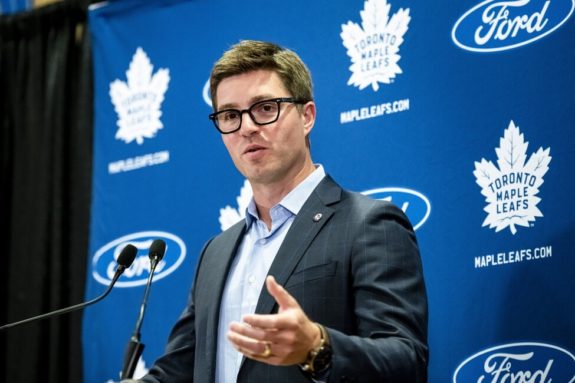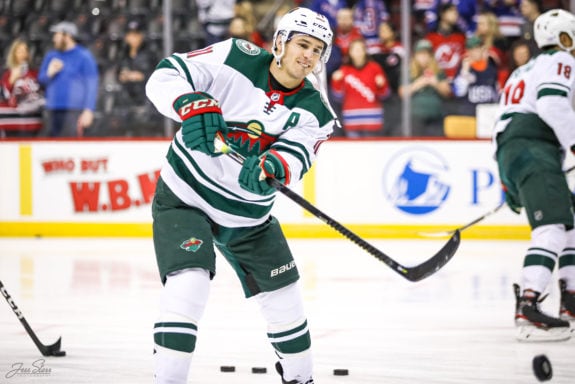Sheldon Keefe is coaching the team that general manager Kyle Dubas has put together, and so far the results are beyond positive. In watching Dubas work over the past two seasons, I believe he had something specific in mind when he built this Toronto Maple Leafs team.
Related: Ex-Maple Leafs’ Mike Babcock: Stubborn, Confusing, and Out of Work
Specifically, he wanted speedy, skilled players who could become so efficient at puck-possession hockey that their opponents would never have a chance to mount an offense of their own. That’s exactly what fans saw against the Detroit Red Wings in Wednesday night’s 6-0 victory.
In a game where the Maple Leafs simply overwhelmed the Red Wings, there were a number of things that Maple Leafs fans should be pleased about. First, the team won its third straight game under their new head coach. Second, fans caught a glimpse of how both Keefe and general manager Dubas envision the team playing. Third, they saw what the team is capable of when that kind of hockey works well.

The game was a rout. The undermanned (Detroit was suffering a number of injuries) Red Wings simply didn’t stand a chance and were completely frustrated by the Maple Leafs constant and overwhelming pressure. It was no match.
Related: Maple Leafs Fire Babcock, Name Keefe Head Coach
Kudos to goalie Frederik Andersen, who got his first shutout of the season and the 17th of his career. The game was all Maple Leafs until it was too late; still, Andersen had to make some big saves in the final period to preserve the shutout. The 30-year-old goalie now has won three starts in a row and has had a great November with a 6-3-1 record, a 2.07 goals-against average, and .936 save percentage.
Maple Leafs’ Fourth Line Puts on a Clinic
In fact, until the score was 6-0, the Red Wings simply couldn’t collect the puck to make any kind of offensive move out of their own zone. In a well-written post on Yahoo Sports Canada that mirrored what I saw exactly, Nick Ashbourne gave an example of how he believed the Maple Leafs hoped to play.
As Ashbourne explains, the fans saw the “new-look Maple Leafs.” He describes a second-period sequence where the fourth line of Frederik Gauthier, Pierre Engvall, and Dmytro Timashov hemmed the Red Wings’ line of Dylan Larkin, Tyler Bertuzzi, and Robby Fabbri in their own zone for “a full 77 seconds, putting on a clinic in the type of position-flexible cycling they hope to perfect under Keefe.”
Puck-Possession Offensive Pressure: So What?
Ashbourne called it “picture-perfect offensive pressure.” He’s right. I too have no doubt it’s the way Dubas envisioned his team playing. The focus was on puck possession, grounded by the simple philosophy that when your team has the puck the other team simply can’t score.

The team’s win against the Red Wings was a perfect example of why puck possession is so valuable. When the Maple Leafs owned the puck against the Red Wings, they both increased puck-possession time and created numerous chances to score, simply because they held a constant territorial advantage.
Since the Red Wings couldn’t get out of their own defensive zone, they never mounted an offense. In fact, a number of times the Maple Leafs even made line changes (while the Red Wings could not) during their time in the Detroit zone, crushing their opponents towards physical and mental exhaustion. And, they kept scoring.
Related: Maple Leafs News & Rumors: Keefe, Engvall, Barrie, Mikheyev & Kadri
That puck-position offense is what the Maple Leafs’ “new-look” hockey looks like and the kind of play the team will work to establish over the remainder of the season. It’s part of the NHL’s transformation over the last few seasons. It fits the modus operandi of the team Dubas has worked to build. In one specific example, that’s why it made sense to trade Nazem Kadri for Tyson Barrie and Alex Kerfoot.
The Historical Change that Brought Us Today’s Maple Leafs
Historically, the NHL emphasized the gift of physical size. No longer. True power forwards, such as Ryan Getzlaf (of the Anaheim Ducks) and Dustin Brown (Los Angeles Kings), are disappearing. Shane Doan (Arizona Coyotes) and Rick Nash (Columbus Blue Jackets and New York Rangers) have retired. Meanwhile, Milan Lucic (Calgary Flames) is struggling to be relevant.
Leon Draisaitl and Auston Matthews have great size, but they’re not like the power forwards of the past. Each is a highly-skilled, puck-handling, quick-thinking forward for whom size is an advantage, but not THE advantage. They carry the puck rather than dumping-and-chasing.

Hockey teams once asked players to dump-and-chase and then aggressively forechecked to regain control. Their goal was to get the puck deep, forecheck, and force turnovers. No longer. In today’s NHL, about the only time a team dumps the puck deep is to make a line change or to relieve overwhelming pressure when a player is in deep trouble.
NHL defenses have caught up to the dump-and-chase offense. Today’s defensemen are taught to retrieve the puck and create breakouts. Teams are coached to quickly turn another team’s purposeful giveaways into quick transition attacks in the other direction. In fact, the way penalties are called has encouraged that change. Obstruction penalties, such as hooking and holding, are called more often than they’ve been in the past.
Related: Barrie Leads Maple Leafs past Avalanche 5-3
Finally, which is the case for the Maple Leafs, dump-and-chase hockey doesn’t allow creative opportunities for highly-skilled players. If a team has smart and skilled players, it’s wise to let those players engage those skills.
Specifically, if you’re the Maple Leafs with a player like Matthews, you don’t want him to dump-and-chase. You want him to “possess” the puck until he sees and creates offensive chances. Maple Leafs hockey is now about winning games by possessing the puck and pressuring the defense, for as long and often as possible.
Puck possession doesn’t require size; it requires skill, creativity, and desire. For example, when Dubas traded for Nic Petan last February, he said exactly: “He’s a player that fits the way we want to play.”
Can your team hold onto the puck, think and see the ice, and pass it to a teammate who has a better offensive chance? If it can, you’ll be tough to beat. Opponents simply won’t be able to gain the puck to create their own offensive advantage.
Welcome to Maple Leafs’ Puck-Possession Hockey
I recently read the website of the American Development Model, a US nationwide model that’s trying to help develop successful American hockey players. The website quoted Zach Parise (Minnesota Wild) discussing puck possession.
Parise said, “It’s a possession game. I read a study that showed shots generated off carrying the puck in as opposed to dumping it in, and it’s like 4-to-1. It’s not even close. I just found it so interesting because everyone’s like, ‘forecheck, forecheck, forecheck.’”

He added, “I get it, but when you dump the puck, you have to get it back. All you’re doing is giving the puck away. I mean it’s so hard to get it, why would you give it away?”
There’s a saying in youth hockey something like “Tight turn, make a play, never give the puck away.” It makes sense.
Related: Why Aren’t the Toronto Maple Leafs Trying Harder?
The Maple Leafs will play puck-possession hockey the remainder of the season. Will it be good enough to push them past the first round of the playoffs? That question will be answered over the next few months.